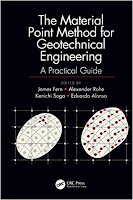Frozen Ground Engineering 2nd Edition
Orlando B. Andersland, Branko Ladanyi ... 384 pages - Publisher: Wiley; 2nd edition (November, 2003) ... Language: English - ISBN-10: 0471615498 - ISBN-13: 978-0471615491.
This new edition of Frozen Ground Engineering gives a peerless presentation of soil mechanics for frozen ground conditions and a variety of frozen ground support systems used on construction projects worldwide. An authoritative update of the industry standard, this Second Edition covers the essential theory, applications, and design methods using frozen ground in the construction of deep shafts, tunnels, deep excavations, and subsurface containment barriers. New material features design models for pavement structures used in seasonal frost and permafrost areas, new information on the movement of fluid phase contaminants in frozen ground, and helpful appendices offering guidance on common frozen ground tests and SI unit conversions.
This new edition gives the essential information engineers, geologists, and students need in a complete reference, including up-to-date information on: * Sensitivity of frozen ground to climate change * Experimental work on frozen soil creep and strength * Monitoring creep in frozen slopes * Frost protection of foundations using ground insulation * Highway insulation * Load restrictions for seasonal frost areas.
This new edition of Frozen Ground Engineering gives a peerless presentation of soil mechanics for frozen ground conditions and a variety of frozen ground support systems used on construction projects worldwide. An authoritative update of the industry standard, this Second Edition covers the essential theory, applications, and design methods using frozen ground in the construction of deep shafts, tunnels, deep excavations, and subsurface containment barriers. New material features design models for pavement structures used in seasonal frost and permafrost areas, new information on the movement of fluid phase contaminants in frozen ground, and helpful appendices offering guidance on common frozen ground tests and SI unit conversions.
This new edition gives the essential information engineers, geologists, and students need in a complete reference, including up-to-date information on: * Sensitivity of frozen ground to climate change * Experimental work on frozen soil creep and strength * Monitoring creep in frozen slopes * Frost protection of foundations using ground insulation * Highway insulation * Load restrictions for seasonal frost areas.



















